Squeeze all the juices from the free version of Veeam Backup & Replication
Let's get it straight: no one likes to pay a lot for software. And for some, “many” is all that is more than the price of a daily lunch. Even when it comes to professional software for professionals, if a slightly less paid competitor with fewer functions appears on the horizon, he immediately attracts a lot of attention, and in the minds of the bewildered public, the question arises: “Or maybe bust these very functions, and there is no reason to pay for them? " In response, some manufacturers are beginning to look for new, relatively honest methods of withdrawing money from the public, and they introduce subscription services, which, as a first approximation, allow paying much less for software.
Another approach to the problem is a clear understanding of what functionality is needed at the level of home and / or laboratory use, and which at the level of large corporations. And after Zen is comprehended, all the “home” functionality becomes free, and for the rest they ask for money.
Today I suggest that you consider the second model, finding out that Veeam offers its users for free and if this is not enough for daily personal use. Even if a small buy-sell office, or a simple startup, which believes that a “bloody vendor” wants too much money for its products, peeps out from under the “personal” one.
If you doubt that they give really powerful tools, without asking for anything in return and that this is the case - welcome under cat.
')
So, what we have as a first approximation:
• The flagship product Veeam Backup & Replication, which has a very good set of functions that can be used absolutely free of charge, i.e. for nothing.
• On the other hand, some features are available only to owners of a paid license, and very few are only available at a premium level for Enterprise licensees or celestials with Enterprise Plus.
Without a shadow of a doubt, the main thing that the software responsible for creating backup copies should do is ... a drum roll ... backups! In the large version (read, the one for the money), the simplified backup function is fully present and is called VeeamZIP. At the same time, the most important thing to take a sigh about is that in the free version there is no function to create backups on a schedule, and you have to do everything by hand, and the “bloody vendor” takes money for such a simple piece.
And you might think that yes, people are sad because they were given an unfinished tool and are forced to pay for the most primitive functionality. If it were not for one “But!” - no one imposed a ban on reading the manual on the PowerShell SDK, did not hide the manual itself, and this was not the prohibition of the SDK itself. And even put it in the installation image.
And this is the only difference from the backup mechanism in the paid version. Otherwise, the backup of the virtual machine will be created using exactly the same algorithm as in the case of using the license for several thousand dollars. In my opinion, this is a very good gesheft for an evening of fascinating reading ...
As can be seen in the screenshot below, that in the Free version, that in the case of a license, everything is in the same place. Just a little less opportunity.

And so we need backups in a safe place, but the terrible happens, and we need to urgently recover information. The first thing that comes to mind is the free version, you can probably restore only half of the car. Or one file. Or some kind of inconvenient horror typical of demo / free versions.
But in practice, everything is much more prosaic!
The free version of Backup & Replication, without any restrictions and offensive annotations, allows you to restore information dear to your heart in three ways: return the entire machine, remove a separate virtual disk from backup, or restore a separate file from the guest OS level.
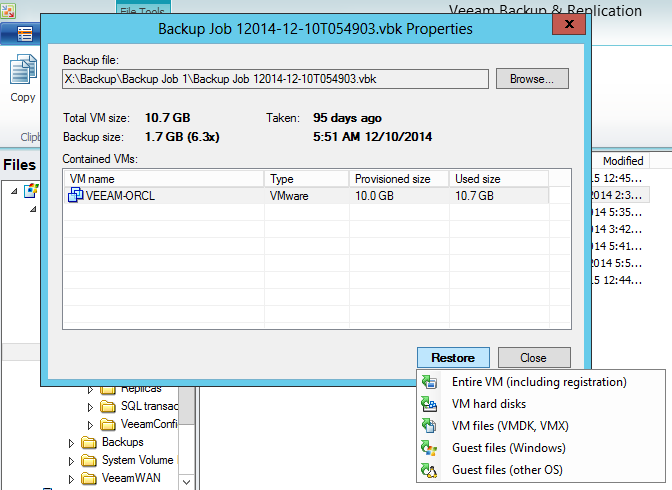
But, strictly speaking, there is also a fourth option - it is possible to restore information at the application level. And it is so great that I decided to devote a separate paragraph to this opportunity.
So which applications are we talking about? Of course, we try to support all the most popular applications and services of corporate environments, but at the moment the free version allows you to recover elements of Microsoft Exchange, Microsoft SharePoint, Microsoft SQL Server and, of course, Active Directory from the same Microsoft. And this list will only expand and never - narrow!
The only feature that is important to mention right away is that you have to manually start any recovery wizard from the program folder and prescribe the necessary settings or go a little more simple way - in the guest OS file recovery wizard window, you can start the necessary wizard with automatic substitution of a part of the settings. While in the full version, everything happens automatically. But this stuff.
I suggest the first to consider the wizard restore items Exchange.
Negligent user deleted the letter, and you have so successfully made backup of your Exchange machine? Our Exchange Recovery Wizard will allow you to remove any object from the mailer database from backup! And as if nothing had happened. Or just look at the contents of the item you need in the Recovery Wizard window, if there is no desire to complicate the process.
Speaking in a dry language, directly from the backup, without unnecessary gestures, you can remove .pst objects or individual .eml. Unfortunately, it will not be possible to restore directly to the base of the combat server, but the existing functions will be enough in abundance.

Absolutely the same story with SharePoint. Without asking for a penny, we give a tool that can restore the desired object to any convenient place, if only everyone would be happy. The only limitation of the Free version is that you cannot restore objects to a live database. But to ban import them there after recovery, we can not.
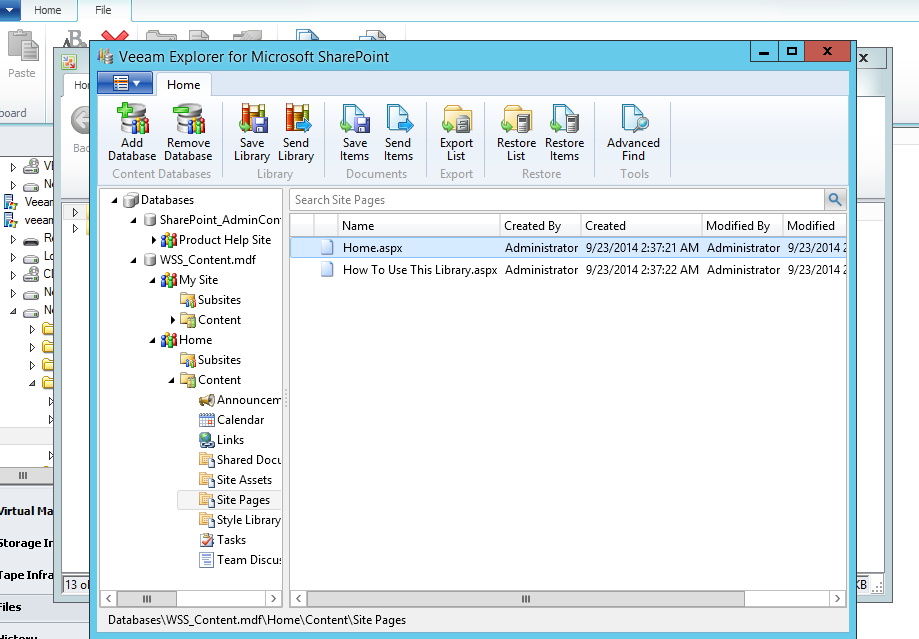
And with the release of the latest version, we decided to “Walk - so walk!” And gave the grateful public tools for recovering Microsoft SQL objects and Active Directory.
I do not want to dwell on the restoration of SQL Server databases for a long time, because it works exactly as expected.

And the main star in my personal hit parade is, undoubtedly, the master of the restoration of Active Directory objects. Here the soul can turn to its fullest, reviving both individual users and their entire groups. And even the passwords of these users can be returned to its original state. Very handy tool with thousands of options to apply.
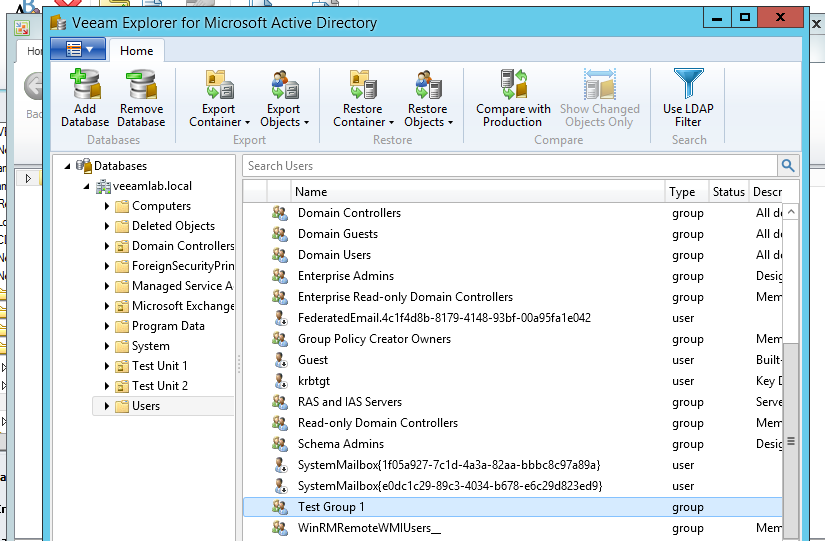
Surely it is no secret for anyone that any more or less serious data storage should be able to make snapshots of structures stored on it, removing this sad duty from third-party applications, because it is logical that no one can do it better.
What you can do next with these snapshots is a separate question, but one of the available functions is the ability to recover information. And here everything is not so rosy, because This process is not so technically complex, as it requires the knowledge of certain truths, the development of tools and the ability to apply the latter to the former.
In the wake of making life easier for good people, we decided that it would be nice to simplify everything with a few mouse clicks, and successfully implemented this venture!
If you are the lucky owner of HP StoreServ, HP StoreVirtual, (and more recently, the NetApp line has also been added, though only in the paid version), then you have the full range of information recovery capabilities from storage snapshot.
The full set includes: restoring the entire virtuals, restoring individual files from the guest OS level of the machine, as well as all four wizards for restoring application elements - Exchange, SharePoint, SQL and Active Directory.
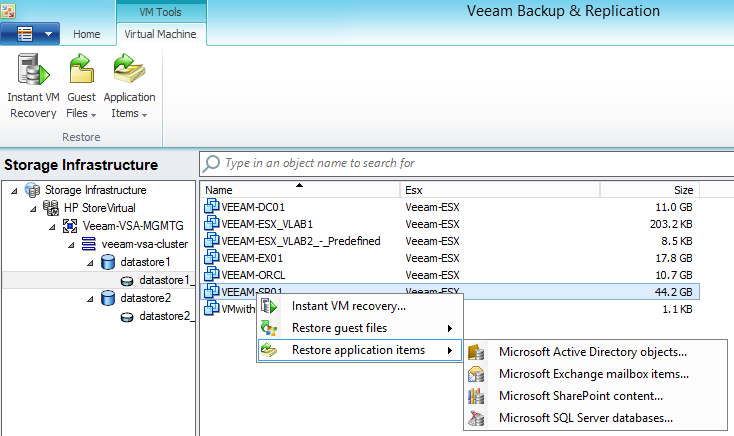
All magic happens very simply - add your storage over IP, and then we will either do it ourselves or find all existing snapshots, understand what they are and what we can recover. On the example of NetApp, we can recover information not only from the usual snapshot copies, but also from SnapMirror and SnapVault. And I think this is very cool.
The title is similar to unhealthy advertising, but everything is fair. Now I will explain how and why.
Once upon a time (by the standards of server virtualization history), VMware introduced technology that allows virtual machines to migrate between hosts, and so cleverly that neither the operating system inside the moving machine, nor the users working with this machine, even suspect that something has changed and happened. The implementation of this function has become one of the most important, and perhaps most important, argument in the dispute about the need to use server virtualization.
Of course, only a fool would miss such an opportunity to earn an extra dollar, and the ability to migrate between hosts began to cost some money.
For our part, guided by the principle of a single point of management, we added the ability to migrate virtual machines directly from the Backup & Replication interface. And of course, to take money for functionality, for which the user has already paid once, the hand does not rise.
But the idea that somewhere in the world there is injustice, and not such a wonderful thing as vMotion is available to everyone, did not allow our developers to rest on their laurels, and they sat down to think. Think very hard.
The result of thinking was our version of the migration of machines, which, although it does not allow you to do everything as cool as in the case of a full-fledged vMotion, but reduces the downtime of the migrated machine to the technically possible minimum.
And, unlike vMotion, our mechanism allows us to transfer machines even between clusters.
Actually happiness, in the screenshot:

Immediately after you have added your host or hosts to our program, all the contents of their datastores will be displayed on the Files tab. In the example in the screenshot, several simple Windows machines, Hyper-V host, ESXi host and machine with vCenter were added to the program.
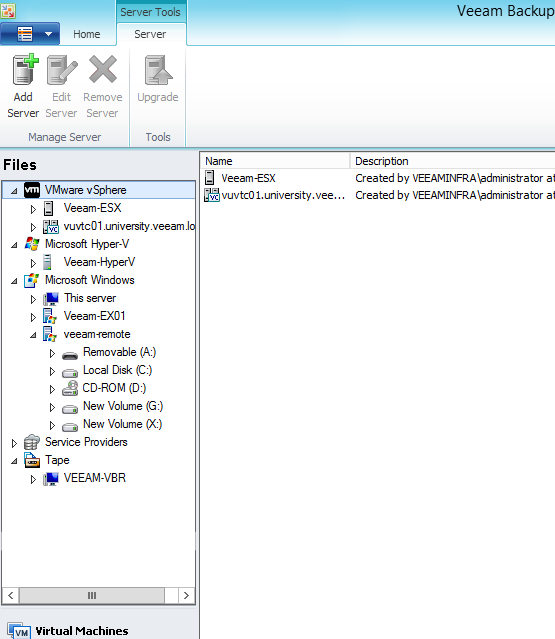
What does this give us? The answer is obvious - the ability to work with files, namely, copy and transfer files without restrictions within the most cunning infrastructures. In the first approximation, everything looks very simple, but you quickly get involved because the tools that come with the hypervisor are very inconvenient in terms of file operations. In our case, you can work with files as in a normal explorer, copying anything, where we want and where it will be, without painful passes with our hands.
It is based on the utility independent FastSCP utility, which is available for free download.
I note that the data will be exchanged not by a frontal attack, but only after analyzing all possible transmission options, using compression, removing empty blocks and other useful actions aimed at speeding up the transfer of files.
An excellent addition is the ability to create a File Copy job, in which you can automate the sending of a set of files on a schedule. It is convenient, for example, to send all backups at the end of the week for remote storage.
It was also decided to add the ability to work with tape drives. Without limiting ourselves to the interaction with only individual drives, we give the opportunity to use any device, including libraries. The only condition is that you need to have the correct drivers from the manufacturer installed. We do not work with universal ones.
In terms of functionality, everything is simple - you can write files to a ribbon, you can read them from there. If you record a backup, you can immediately restore the necessary information, bypassing the side steps.
The bonus is the ability to run file backup automatically i. an incremental chain of all changes to the original file will be recorded.
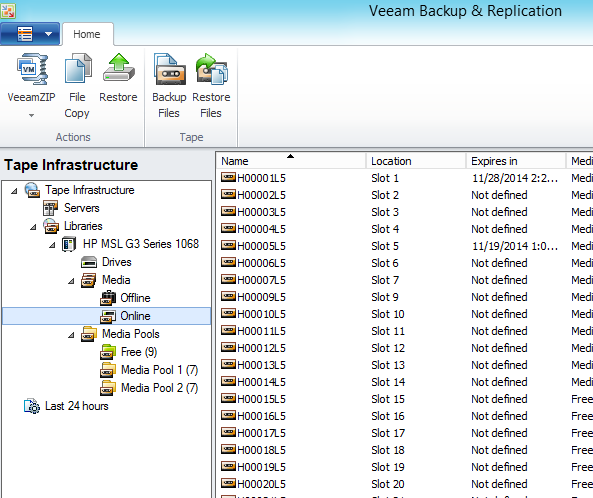
It goes to the utility FastSCP Editor, which once began the story of Veeam.
This is a small, cozy and lamp editor of VMX files i. Do not download vmx first, edit it and upload it back. The addiction is instantaneous and indiscernible.
Well, as is customary in a decent society, at the end a set of links on the topic of the article:
The official article on Habré about the possibilities of the paid and free versions: http://habrahabr.ru/company/veeam/blog/242587/
Pre-release article on Habré with description of application object recovery wizards:
http://habrahabr.ru/company/veeam/blog/223921/
Get the Free Edition here:
http://www.veeam.com/ru/virtual-machine-backup-solution-free.html
And the blessed guide to the PowerShell SDK (in the language of the likely opponent) is here:
http://helpcenter.veeam.com/backup/80/powershell/index.html?getting_started.html
Another approach to the problem is a clear understanding of what functionality is needed at the level of home and / or laboratory use, and which at the level of large corporations. And after Zen is comprehended, all the “home” functionality becomes free, and for the rest they ask for money.
Today I suggest that you consider the second model, finding out that Veeam offers its users for free and if this is not enough for daily personal use. Even if a small buy-sell office, or a simple startup, which believes that a “bloody vendor” wants too much money for its products, peeps out from under the “personal” one.
If you doubt that they give really powerful tools, without asking for anything in return and that this is the case - welcome under cat.
')
So, what we have as a first approximation:
• The flagship product Veeam Backup & Replication, which has a very good set of functions that can be used absolutely free of charge, i.e. for nothing.
• On the other hand, some features are available only to owners of a paid license, and very few are only available at a premium level for Enterprise licensees or celestials with Enterprise Plus.
So first do backups
Without a shadow of a doubt, the main thing that the software responsible for creating backup copies should do is ... a drum roll ... backups! In the large version (read, the one for the money), the simplified backup function is fully present and is called VeeamZIP. At the same time, the most important thing to take a sigh about is that in the free version there is no function to create backups on a schedule, and you have to do everything by hand, and the “bloody vendor” takes money for such a simple piece.
And you might think that yes, people are sad because they were given an unfinished tool and are forced to pay for the most primitive functionality. If it were not for one “But!” - no one imposed a ban on reading the manual on the PowerShell SDK, did not hide the manual itself, and this was not the prohibition of the SDK itself. And even put it in the installation image.
And this is the only difference from the backup mechanism in the paid version. Otherwise, the backup of the virtual machine will be created using exactly the same algorithm as in the case of using the license for several thousand dollars. In my opinion, this is a very good gesheft for an evening of fascinating reading ...
As can be seen in the screenshot below, that in the Free version, that in the case of a license, everything is in the same place. Just a little less opportunity.

Chief, everything is gone
And so we need backups in a safe place, but the terrible happens, and we need to urgently recover information. The first thing that comes to mind is the free version, you can probably restore only half of the car. Or one file. Or some kind of inconvenient horror typical of demo / free versions.
But in practice, everything is much more prosaic!
The free version of Backup & Replication, without any restrictions and offensive annotations, allows you to restore information dear to your heart in three ways: return the entire machine, remove a separate virtual disk from backup, or restore a separate file from the guest OS level.

But, strictly speaking, there is also a fourth option - it is possible to restore information at the application level. And it is so great that I decided to devote a separate paragraph to this opportunity.
Constellation of four masters
So which applications are we talking about? Of course, we try to support all the most popular applications and services of corporate environments, but at the moment the free version allows you to recover elements of Microsoft Exchange, Microsoft SharePoint, Microsoft SQL Server and, of course, Active Directory from the same Microsoft. And this list will only expand and never - narrow!
The only feature that is important to mention right away is that you have to manually start any recovery wizard from the program folder and prescribe the necessary settings or go a little more simple way - in the guest OS file recovery wizard window, you can start the necessary wizard with automatic substitution of a part of the settings. While in the full version, everything happens automatically. But this stuff.
I suggest the first to consider the wizard restore items Exchange.
Negligent user deleted the letter, and you have so successfully made backup of your Exchange machine? Our Exchange Recovery Wizard will allow you to remove any object from the mailer database from backup! And as if nothing had happened. Or just look at the contents of the item you need in the Recovery Wizard window, if there is no desire to complicate the process.
Speaking in a dry language, directly from the backup, without unnecessary gestures, you can remove .pst objects or individual .eml. Unfortunately, it will not be possible to restore directly to the base of the combat server, but the existing functions will be enough in abundance.

Absolutely the same story with SharePoint. Without asking for a penny, we give a tool that can restore the desired object to any convenient place, if only everyone would be happy. The only limitation of the Free version is that you cannot restore objects to a live database. But to ban import them there after recovery, we can not.

And with the release of the latest version, we decided to “Walk - so walk!” And gave the grateful public tools for recovering Microsoft SQL objects and Active Directory.
I do not want to dwell on the restoration of SQL Server databases for a long time, because it works exactly as expected.

And the main star in my personal hit parade is, undoubtedly, the master of the restoration of Active Directory objects. Here the soul can turn to its fullest, reviving both individual users and their entire groups. And even the passwords of these users can be returned to its original state. Very handy tool with thousands of options to apply.

Even a snapshot is enough for us if it's a datastorage snapshot
Surely it is no secret for anyone that any more or less serious data storage should be able to make snapshots of structures stored on it, removing this sad duty from third-party applications, because it is logical that no one can do it better.
What you can do next with these snapshots is a separate question, but one of the available functions is the ability to recover information. And here everything is not so rosy, because This process is not so technically complex, as it requires the knowledge of certain truths, the development of tools and the ability to apply the latter to the former.
In the wake of making life easier for good people, we decided that it would be nice to simplify everything with a few mouse clicks, and successfully implemented this venture!
If you are the lucky owner of HP StoreServ, HP StoreVirtual, (and more recently, the NetApp line has also been added, though only in the paid version), then you have the full range of information recovery capabilities from storage snapshot.
The full set includes: restoring the entire virtuals, restoring individual files from the guest OS level of the machine, as well as all four wizards for restoring application elements - Exchange, SharePoint, SQL and Active Directory.

All magic happens very simply - add your storage over IP, and then we will either do it ourselves or find all existing snapshots, understand what they are and what we can recover. On the example of NetApp, we can recover information not only from the usual snapshot copies, but also from SnapMirror and SnapVault. And I think this is very cool.
How to legally use vMotion if there is no money for a license
The title is similar to unhealthy advertising, but everything is fair. Now I will explain how and why.
Once upon a time (by the standards of server virtualization history), VMware introduced technology that allows virtual machines to migrate between hosts, and so cleverly that neither the operating system inside the moving machine, nor the users working with this machine, even suspect that something has changed and happened. The implementation of this function has become one of the most important, and perhaps most important, argument in the dispute about the need to use server virtualization.
Of course, only a fool would miss such an opportunity to earn an extra dollar, and the ability to migrate between hosts began to cost some money.
For our part, guided by the principle of a single point of management, we added the ability to migrate virtual machines directly from the Backup & Replication interface. And of course, to take money for functionality, for which the user has already paid once, the hand does not rise.
But the idea that somewhere in the world there is injustice, and not such a wonderful thing as vMotion is available to everyone, did not allow our developers to rest on their laurels, and they sat down to think. Think very hard.
The result of thinking was our version of the migration of machines, which, although it does not allow you to do everything as cool as in the case of a full-fledged vMotion, but reduces the downtime of the migrated machine to the technically possible minimum.
And, unlike vMotion, our mechanism allows us to transfer machines even between clusters.
Actually happiness, in the screenshot:

Copy gigabyte from here, terabyte here ...
Immediately after you have added your host or hosts to our program, all the contents of their datastores will be displayed on the Files tab. In the example in the screenshot, several simple Windows machines, Hyper-V host, ESXi host and machine with vCenter were added to the program.

What does this give us? The answer is obvious - the ability to work with files, namely, copy and transfer files without restrictions within the most cunning infrastructures. In the first approximation, everything looks very simple, but you quickly get involved because the tools that come with the hypervisor are very inconvenient in terms of file operations. In our case, you can work with files as in a normal explorer, copying anything, where we want and where it will be, without painful passes with our hands.
It is based on the utility independent FastSCP utility, which is available for free download.
I note that the data will be exchanged not by a frontal attack, but only after analyzing all possible transmission options, using compression, removing empty blocks and other useful actions aimed at speeding up the transfer of files.
An excellent addition is the ability to create a File Copy job, in which you can automate the sending of a set of files on a schedule. It is convenient, for example, to send all backups at the end of the week for remote storage.
Ribbons
It was also decided to add the ability to work with tape drives. Without limiting ourselves to the interaction with only individual drives, we give the opportunity to use any device, including libraries. The only condition is that you need to have the correct drivers from the manufacturer installed. We do not work with universal ones.
In terms of functionality, everything is simple - you can write files to a ribbon, you can read them from there. If you record a backup, you can immediately restore the necessary information, bypassing the side steps.
The bonus is the ability to run file backup automatically i. an incremental chain of all changes to the original file will be recorded.

And the nomination - Trifle, but nice
It goes to the utility FastSCP Editor, which once began the story of Veeam.
This is a small, cozy and lamp editor of VMX files i. Do not download vmx first, edit it and upload it back. The addiction is instantaneous and indiscernible.
Well, as is customary in a decent society, at the end a set of links on the topic of the article:
The official article on Habré about the possibilities of the paid and free versions: http://habrahabr.ru/company/veeam/blog/242587/
Pre-release article on Habré with description of application object recovery wizards:
http://habrahabr.ru/company/veeam/blog/223921/
Get the Free Edition here:
http://www.veeam.com/ru/virtual-machine-backup-solution-free.html
And the blessed guide to the PowerShell SDK (in the language of the likely opponent) is here:
http://helpcenter.veeam.com/backup/80/powershell/index.html?getting_started.html
Source: https://habr.com/ru/post/252995/
All Articles